CHEVROLET KODIAK 2006 Workshop Manual
Manufacturer: CHEVROLET, Model Year: 2006, Model line: KODIAK, Model: CHEVROLET KODIAK 2006Pages: 398, PDF Size: 5.72 MB
Page 51 of 398
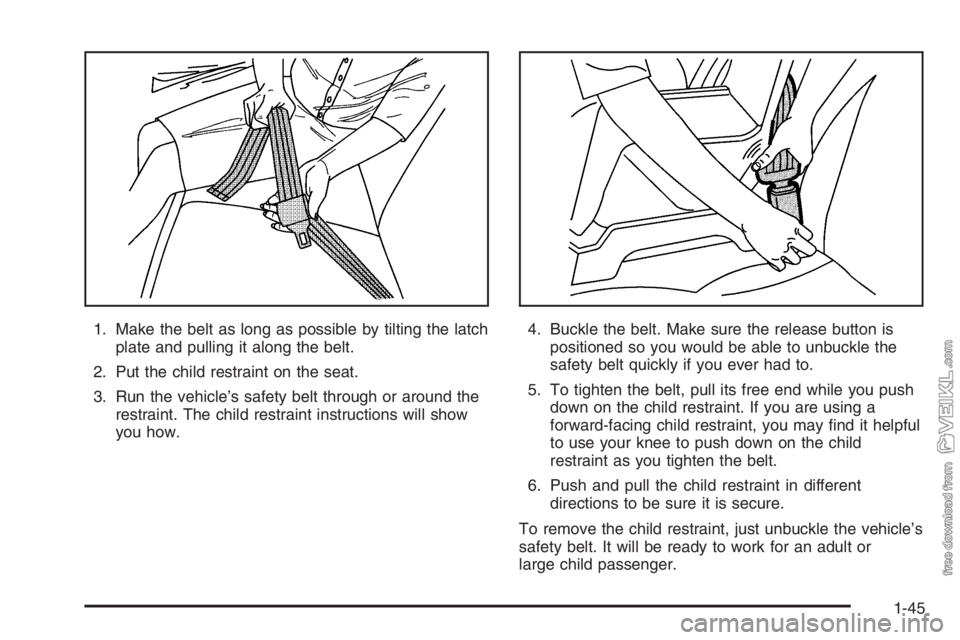
1. Make the belt as long as possible by tilting the latch
plate and pulling it along the belt.
2. Put the child restraint on the seat.
3. Run the vehicle’s safety belt through or around the
restraint. The child restraint instructions will show
you how.4. Buckle the belt. Make sure the release button is
positioned so you would be able to unbuckle the
safety belt quickly if you ever had to.
5. To tighten the belt, pull its free end while you push
down on the child restraint. If you are using a
forward-facing child restraint, you may find it helpful
to use your knee to push down on the child
restraint as you tighten the belt.
6. Push and pull the child restraint in different
directions to be sure it is secure.
To remove the child restraint, just unbuckle the vehicle’s
safety belt. It will be ready to work for an adult or
large child passenger.
1-45
Page 52 of 398
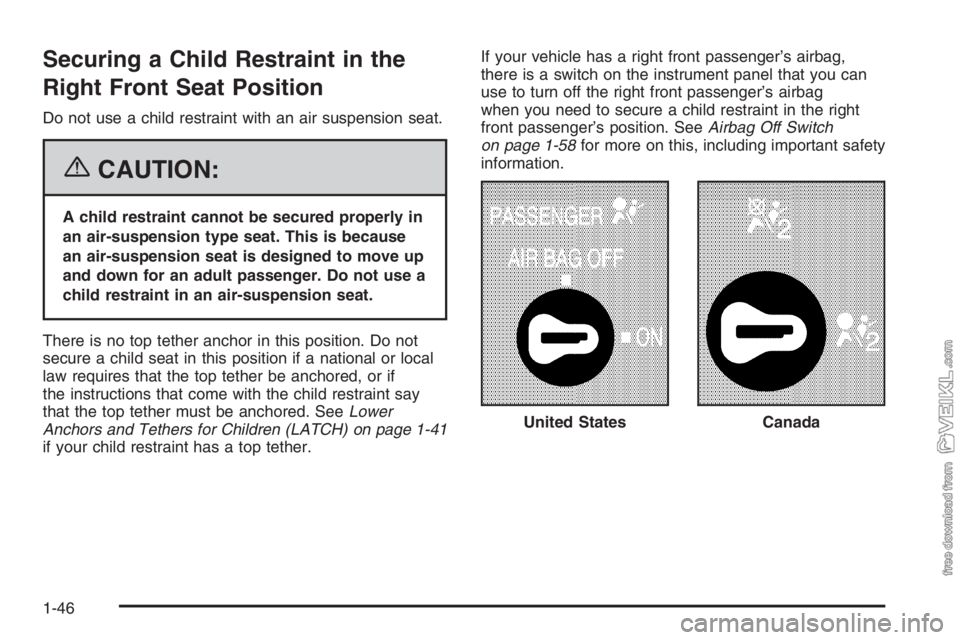
Securing a Child Restraint in the
Right Front Seat Position
Do not use a child restraint with an air suspension seat.
{CAUTION:
A child restraint cannot be secured properly in
an air-suspension type seat. This is because
an air-suspension seat is designed to move up
and down for an adult passenger. Do not use a
child restraint in an air-suspension seat.
There is no top tether anchor in this position. Do not
secure a child seat in this position if a national or local
law requires that the top tether be anchored, or if
the instructions that come with the child restraint say
that the top tether must be anchored. SeeLower
Anchors and Tethers for Children (LATCH) on page 1-41
if your child restraint has a top tether.If your vehicle has a right front passenger’s airbag,
there is a switch on the instrument panel that you can
use to turn off the right front passenger’s airbag
when you need to secure a child restraint in the right
front passenger’s position. SeeAirbag Off Switch
on page 1-58for more on this, including important safety
information.
United States
Canada
1-46
Page 53 of 398
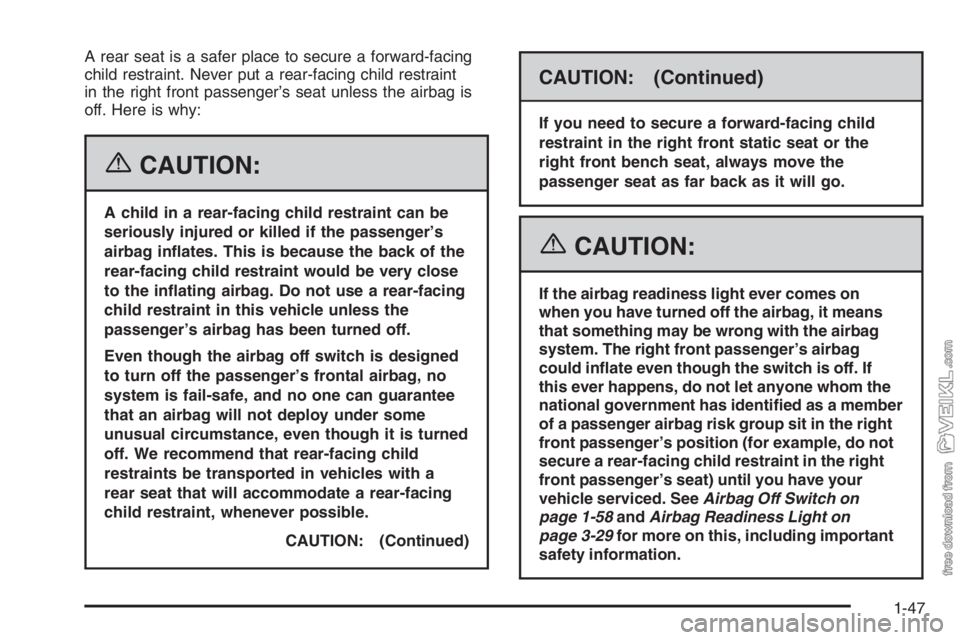
A rear seat is a safer place to secure a forward-facing
child restraint. Never put a rear-facing child restraint
in the right front passenger’s seat unless the airbag is
off. Here is why:
{CAUTION:
A child in a rear-facing child restraint can be
seriously injured or killed if the passenger’s
airbag in�ates. This is because the back of the
rear-facing child restraint would be very close
to the in�ating airbag. Do not use a rear-facing
child restraint in this vehicle unless the
passenger’s airbag has been turned off.
Even though the airbag off switch is designed
to turn off the passenger’s frontal airbag, no
system is fail-safe, and no one can guarantee
that an airbag will not deploy under some
unusual circumstance, even though it is turned
off. We recommend that rear-facing child
restraints be transported in vehicles with a
rear seat that will accommodate a rear-facing
child restraint, whenever possible.
CAUTION: (Continued)
CAUTION: (Continued)
If you need to secure a forward-facing child
restraint in the right front static seat or the
right front bench seat, always move the
passenger seat as far back as it will go.
{CAUTION:
If the airbag readiness light ever comes on
when you have turned off the airbag, it means
that something may be wrong with the airbag
system. The right front passenger’s airbag
could in�ate even though the switch is off. If
this ever happens, do not let anyone whom the
national government has identi�ed as a member
of a passenger airbag risk group sit in the right
front passenger’s position (for example, do not
secure a rear-facing child restraint in the right
front passenger’s seat) until you have your
vehicle serviced. SeeAirbag Off Switch on
page 1-58andAirbag Readiness Light on
page 3-29for more on this, including important
safety information.
1-47
Page 54 of 398
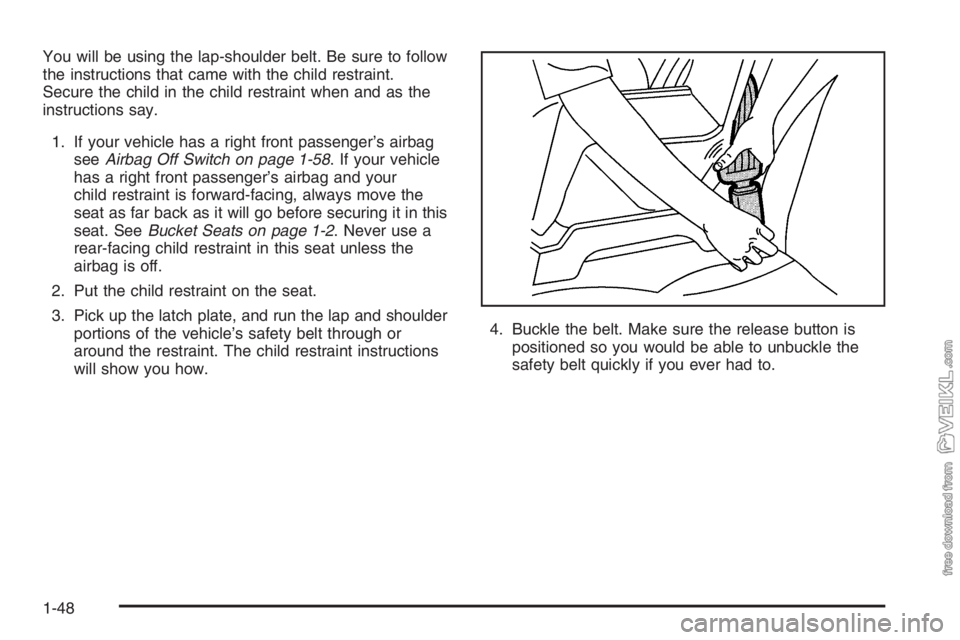
You will be using the lap-shoulder belt. Be sure to follow
the instructions that came with the child restraint.
Secure the child in the child restraint when and as the
instructions say.
1. If your vehicle has a right front passenger’s airbag
seeAirbag Off Switch on page 1-58. If your vehicle
has a right front passenger’s airbag and your
child restraint is forward-facing, always move the
seat as far back as it will go before securing it in this
seat. SeeBucket Seats on page 1-2. Never use a
rear-facing child restraint in this seat unless the
airbag is off.
2. Put the child restraint on the seat.
3. Pick up the latch plate, and run the lap and shoulder
portions of the vehicle’s safety belt through or
around the restraint. The child restraint instructions
will show you how.4. Buckle the belt. Make sure the release button is
positioned so you would be able to unbuckle the
safety belt quickly if you ever had to.
1-48
Page 55 of 398
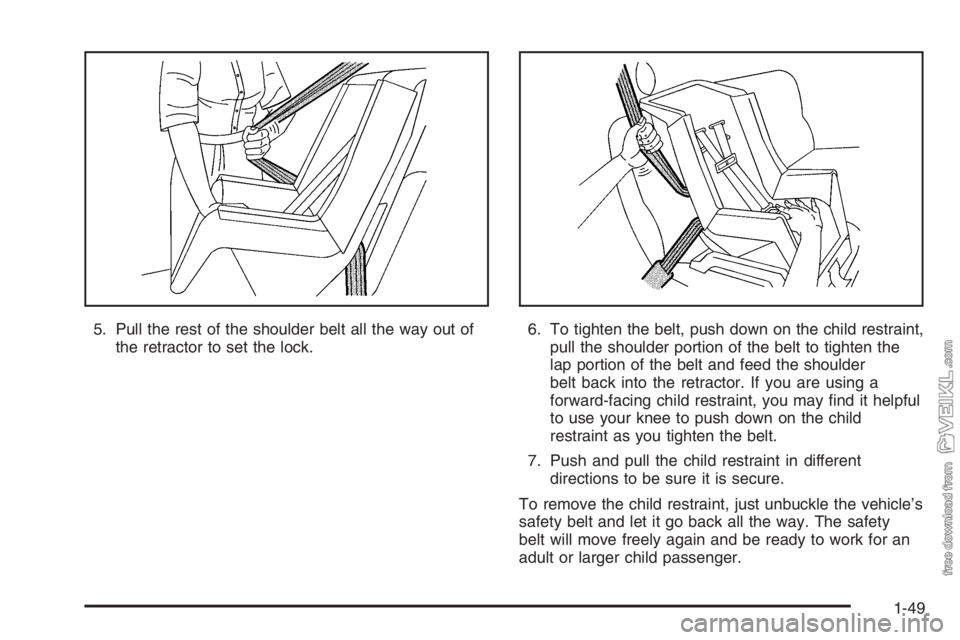
5. Pull the rest of the shoulder belt all the way out of
the retractor to set the lock.6. To tighten the belt, push down on the child restraint,
pull the shoulder portion of the belt to tighten the
lap portion of the belt and feed the shoulder
belt back into the retractor. If you are using a
forward-facing child restraint, you may find it helpful
to use your knee to push down on the child
restraint as you tighten the belt.
7. Push and pull the child restraint in different
directions to be sure it is secure.
To remove the child restraint, just unbuckle the vehicle’s
safety belt and let it go back all the way. The safety
belt will move freely again and be ready to work for an
adult or larger child passenger.
1-49
Page 56 of 398
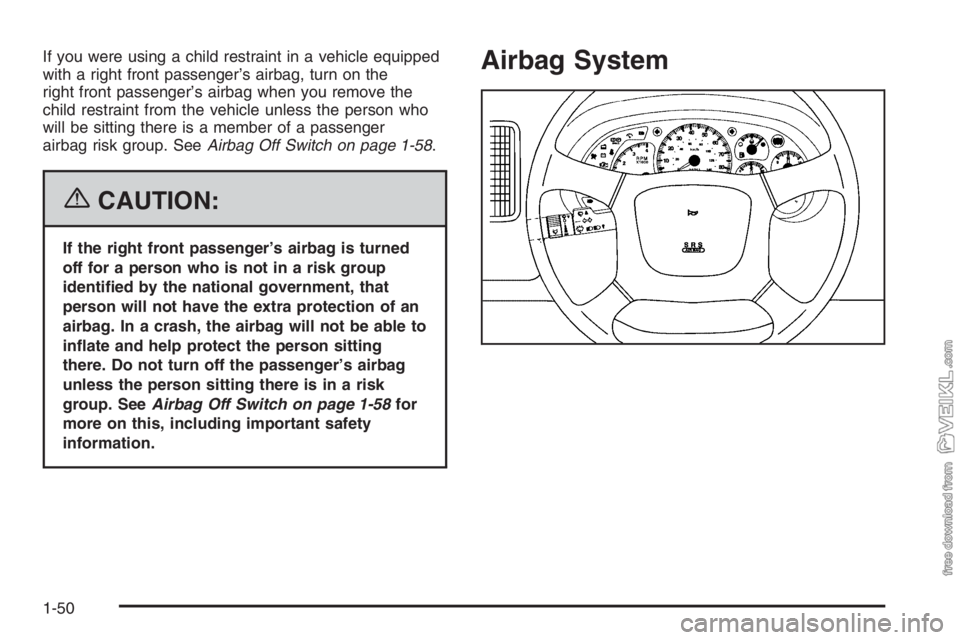
If you were using a child restraint in a vehicle equipped
with a right front passenger’s airbag, turn on the
right front passenger’s airbag when you remove the
child restraint from the vehicle unless the person who
will be sitting there is a member of a passenger
airbag risk group. SeeAirbag Off Switch on page 1-58.
{CAUTION:
If the right front passenger’s airbag is turned
off for a person who is not in a risk group
identi�ed by the national government, that
person will not have the extra protection of an
airbag. In a crash, the airbag will not be able to
in�ate and help protect the person sitting
there. Do not turn off the passenger’s airbag
unless the person sitting there is in a risk
group. SeeAirbag Off Switch on page 1-58for
more on this, including important safety
information.
Airbag System
1-50
Page 57 of 398
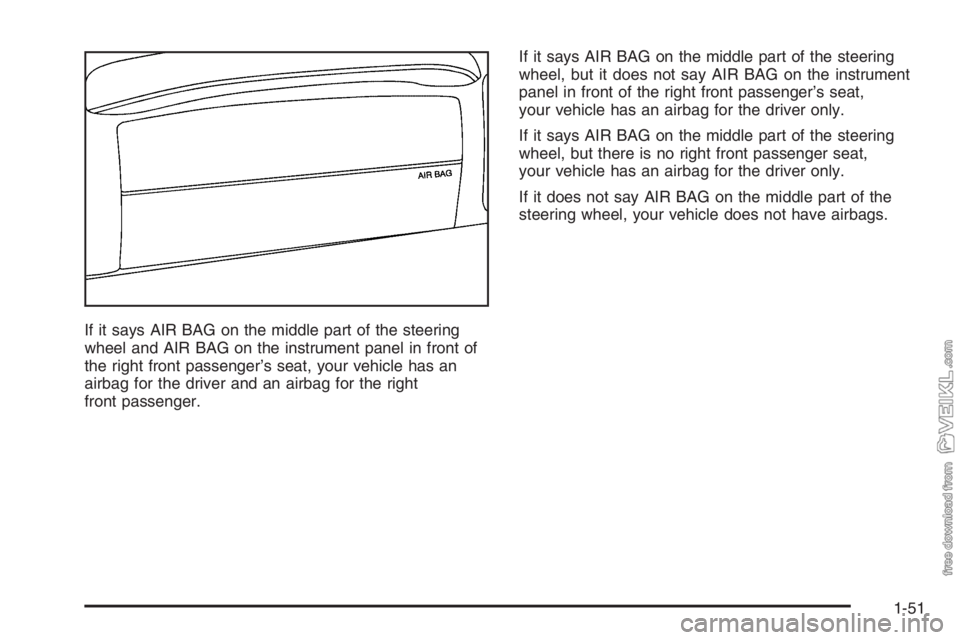
If it says AIR BAG on the middle part of the steering
wheel and AIR BAG on the instrument panel in front of
the right front passenger’s seat, your vehicle has an
airbag for the driver and an airbag for the right
front passenger.If it says AIR BAG on the middle part of the steering
wheel, but it does not say AIR BAG on the instrument
panel in front of the right front passenger’s seat,
your vehicle has an airbag for the driver only.
If it says AIR BAG on the middle part of the steering
wheel, but there is no right front passenger seat,
your vehicle has an airbag for the driver only.
If it does not say AIR BAG on the middle part of the
steering wheel, your vehicle does not have airbags.
1-51
Page 58 of 398
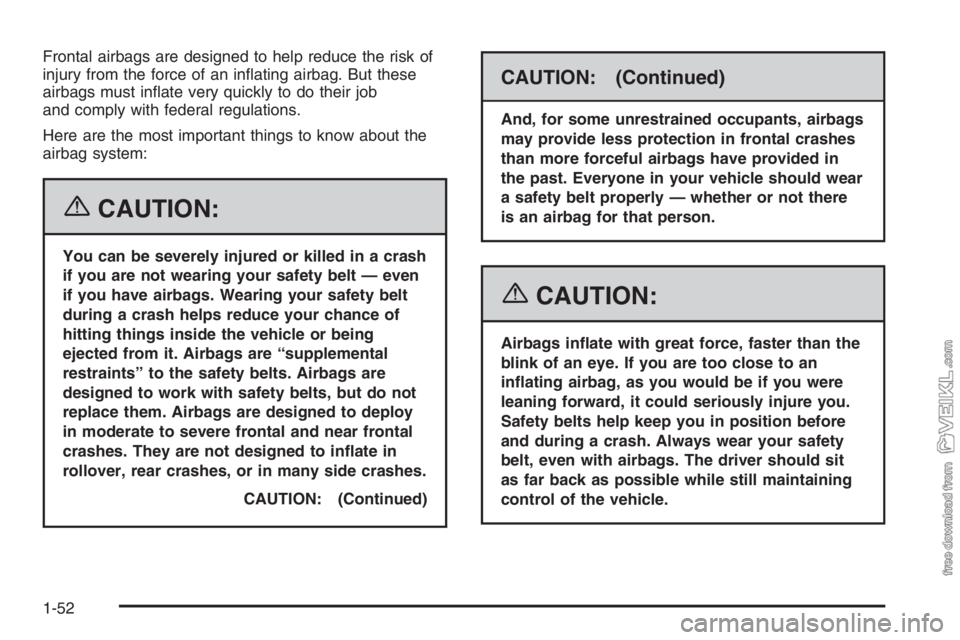
Frontal airbags are designed to help reduce the risk of
injury from the force of an inflating airbag. But these
airbags must inflate very quickly to do their job
and comply with federal regulations.
Here are the most important things to know about the
airbag system:
{CAUTION:
You can be severely injured or killed in a crash
if you are not wearing your safety belt — even
if you have airbags. Wearing your safety belt
during a crash helps reduce your chance of
hitting things inside the vehicle or being
ejected from it. Airbags are “supplemental
restraints” to the safety belts. Airbags are
designed to work with safety belts, but do not
replace them. Airbags are designed to deploy
in moderate to severe frontal and near frontal
crashes. They are not designed to in�ate in
rollover, rear crashes, or in many side crashes.
CAUTION: (Continued)
CAUTION: (Continued)
And, for some unrestrained occupants, airbags
may provide less protection in frontal crashes
than more forceful airbags have provided in
the past. Everyone in your vehicle should wear
a safety belt properly — whether or not there
is an airbag for that person.
{CAUTION:
Airbags in�ate with great force, faster than the
blink of an eye. If you are too close to an
in�ating airbag, as you would be if you were
leaning forward, it could seriously injure you.
Safety belts help keep you in position before
and during a crash. Always wear your safety
belt, even with airbags. The driver should sit
as far back as possible while still maintaining
control of the vehicle.
1-52
Page 59 of 398
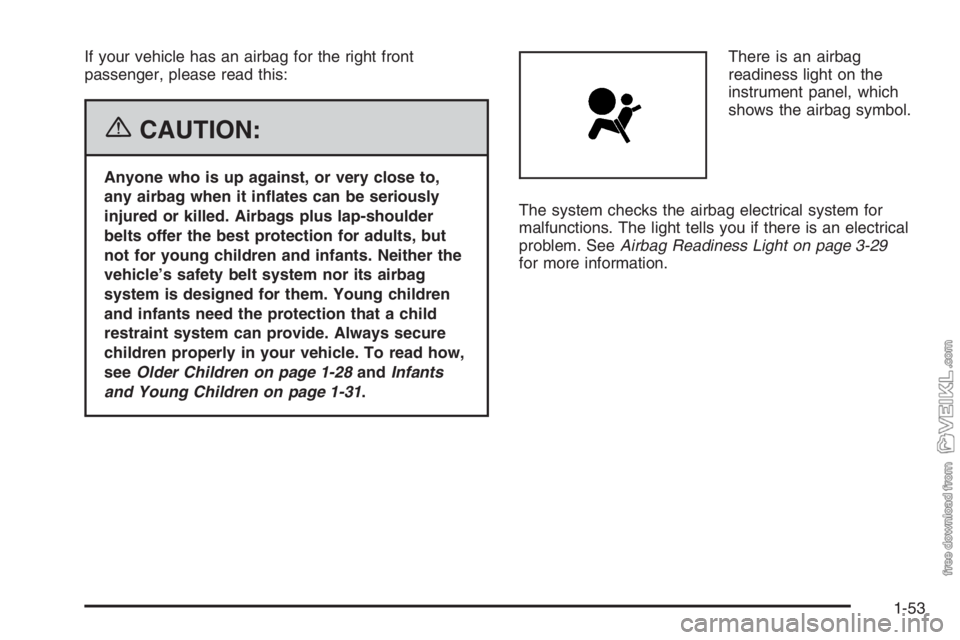
If your vehicle has an airbag for the right front
passenger, please read this:
{CAUTION:
Anyone who is up against, or very close to,
any airbag when it in�ates can be seriously
injured or killed. Airbags plus lap-shoulder
belts offer the best protection for adults, but
not for young children and infants. Neither the
vehicle’s safety belt system nor its airbag
system is designed for them. Young children
and infants need the protection that a child
restraint system can provide. Always secure
children properly in your vehicle. To read how,
seeOlder Children on page 1-28andInfants
and Young Children on page 1-31.There is an airbag
readiness light on the
instrument panel, which
shows the airbag symbol.
The system checks the airbag electrical system for
malfunctions. The light tells you if there is an electrical
problem. SeeAirbag Readiness Light on page 3-29
for more information.
1-53
Page 60 of 398
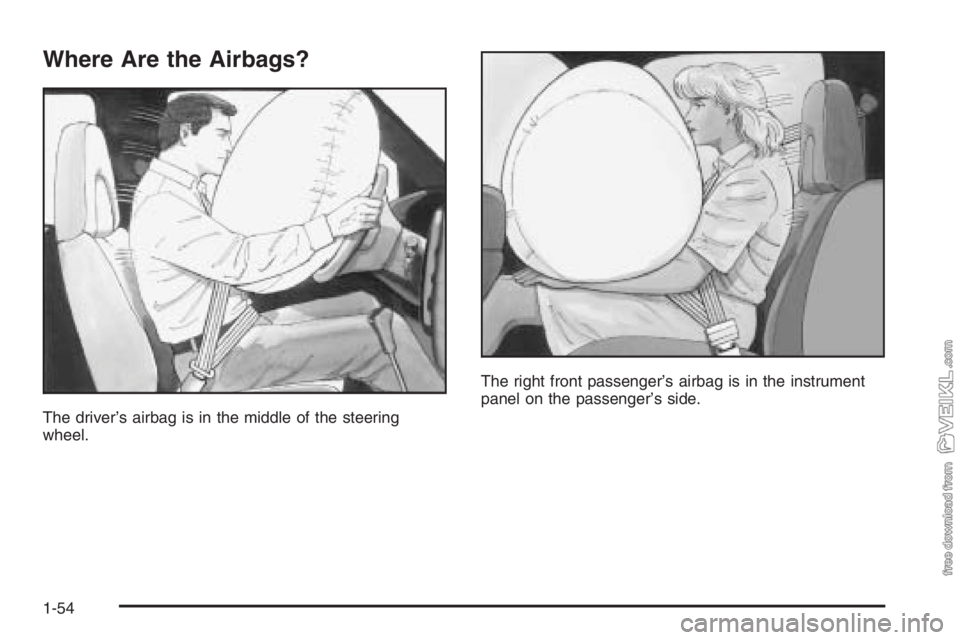
Where Are the Airbags?
The driver’s airbag is in the middle of the steering
wheel.The right front passenger’s airbag is in the instrument
panel on the passenger’s side.
1-54